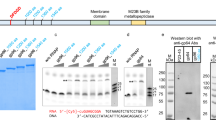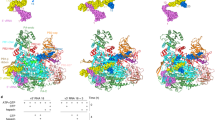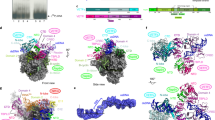Abstract
A small protein, VPg, is covalently linked to the 5′ end of the plus-stranded poliovirus genomic RNA1,2,3. Poliovirus messenger RNA, identical in nucleotide sequence to genomic RNA, is not capped at its 5′ end by the methylated structure that is common to most eukaryotic mRNAs. These discoveries presented two problems. First, as cap structures are usually required for translation of mRNA into protein, how does this uncapped viral RNA act as a template for translation? Second, what is the function of VPg? The identification of the internal ribosomal-entry site, which allows the entry of ribosomes into viral mRNA independently of the 5′ mRNA end, has solved the first conundrum4,5,6. Here we describe the resolution of the second problem. VPg is linked to the genomic RNA through the 5′-terminal uridylic acid of the RNA. We show that VPg can be uridylylated by the poliovirus RNA polymerase 3Dpol. Uridylylated VPg can then prime the transcription of polyadenylate RNA by 3Dpol to produce VPg-linked poly(U). Initiation of transcription of the poliovirus genome from the polyadenylated 3′ end therefore depends on VPg.
This is a preview of subscription content, access via your institution
Access options
Subscribe to this journal
Receive 51 print issues and online access
$199.00 per year
only $3.90 per issue
Buy this article
- Purchase on Springer Link
- Instant access to full article PDF
Prices may be subject to local taxes which are calculated during checkout







Similar content being viewed by others
References
Lee, Y. F., Nomoto, A. & Wimmer, E. in Progress in Nucleic Acid Research and Molecular Biology (eds Davidson, J. N. & Coh, W. E.) 89–96 (Academic, New York, (1976)).
Lee, Y. F., Nomoto, A., Detjen, B. M. & Wimmer, E. Aprotein covalently linked to poliovirus genome RNA. Proc. Natl Acad. Sci. USA 74, 59–63 (1977).
Flanegan, J. B., Petterson, R. F., Ambros, V., Hewlett, M. J. & Baltimore, D. Covalent linkage of a protein to a defined nucleotide sequence at the 5′ terminus of the virion and replicative intermediate RNAs of poliovirus. Proc. Natl Acad. Sci. USA 74, 961–965 (1977).
Jang, S. K. et al. Asegment of the 5′ nontranslated region of encephalomyocarditis virus RNA directs internal entry of ribosomes during in vitro translation. J. Virol. 62, 2636–2643 (1988).
Pelletier, J. & Sonnenberg, N. Internal initiation of translation of eukaryotic mRNA directed by a sequence derived from poliovirus RNA. Nature 334, 320–325 (1988).
Molla, A., Jang, S. K., Paul, A. V., Reuer, Q. & Wimmer, E. Cardioviral internal ribosomal entry site is functional in a genetically engineered dicistronic poliovirus. Nature 356, 255–257 (1992).
Kitamura, N. et al. Primary structure, gene organization, and polypeptide expression of poliovirus RNA. Nature 291, 547–553 (1981).
Rothberg, P. G., Harris, T. J. R., Nomoto, A. & Wimmer, E. O4-(5′-uridylyl)tyrosine is the bond between the genome-linked protein and the RNA of poliovirus. Proc. Natl Acad. Sci. USA 75, 4868–4872 (1978).
Ambros, V. & Baltimore, D. Protein is linked to the 5′ end of poliovirus RNA by a phosphodiester linkage to tyrosine. J. Biol. Chem. 253, 5263–5266 (1978).
Takegami, T., Kuhn, R. J., Anderson, C. W. & Wimmer, E. Membrane-dependent uridylylation of the genome-linked protein VPg of poliovirus. Proc. Natl Acad. Sci. USA 80, 7447–7451 (1983).
Takeda, N., Kuhn, R. J., Yang, C.-F., Takegami, T. & Wimmer, E. Initiation of poliovirus plus-strand RNA synthesis in a membrane complex of infected HeLa cells. J. Virol. 60, 43–53 (1986).
Toyoda, H., Yang, C.-F., Takeda, N., Nomoto, A. & Wimmer, E. Analysis of RNA synthesis of type 1 poliovirus by using an in vitro molecular genetic approach. J. Virol. 61, 2816–2822 (1987).
Flanegan, J. B. & Baltimore, D. Poliovirus-specific primer-dependent RNA polymerase able to copy poly(A). Proc. Natl Acad. Sci. USA 74, 3677–3680 (1977).
Yogo, Y. & Wimmer, E. Polyadenylic acid at the 3′-terminus of poliovirus RNA. Proc. Natl Acad. Sci. USA 69, 1877–1882 (1972).
Yogo, Y. & Wimmer, E. Sequence studies of poliovirus RNA. III. Polyuridylic acid and polyadenylic acid as components of the purified poliovirus replicative intermediate. J. Mol. Biol. 92, 467–477 (1975).
Dorsch-Haesler, K., Yogo, Y. & Wimmer, E. Replication of picornaviruses. I. Evidence from in vitro RNA synthesis that poly(A) of the poliovirus genome is genetically coded. J. Virol. 16, 1512–1517 (1975).
Nomoto, A., Detjen, B. M., Pozatti, R. & Wimmer, E. The location of the polio genome protein in viral RNAs and its implication for RNA synthesis. Nature 268, 208–213 (1977).
Wimmer, E. Genome-linked proteins of viruses. Cell 28, 199–201 (1982).
Esteban, J. A., Bernad, A., Salas, M. & Blanco, L. Metal activation of synthetic and degradative activities of φ29 DNA polymerase, a model enzyme for protein-primed DNA replication. Biochemistry 31, 350–359 (1992).
Pata, J. D., Schultz, S. C. & Kirkegaard, K. Functional oligomerization of poliovirus RNA-dependent RNA polymerase. RNA 1, 466–477 (1995).
Paul, A. . V., Cao, X., Harris, K. S., Lama, J. & Wimmer, E. Stimulation of poly(U) synthesis in vitro by purified poliovirus protein 3AB. J. Biol. Chem. 269, 29173–29181 (1994).
Dreef-Tromp, C. M., van den Elst, H., van den Boogart, J. E., van der Marel, G. A. & van Boom, J. H. Solid-phase synthesis of an RNA nucleopeptide fragment from the nucleoprotein of poliovirus. Nucleic Acids Res. 20, 2435–2439 (1992).
Barton, D. J. et al. Poliovirus RNA polymerase mutation 3D-M394T results in a temperature-sensitive defect in RNA synthesis. Virology 217, 459–469 (1996).
Rodriguez, P. L. & Carrasco, L. Gliotoxin: inhibitor of poliovirus RNA synthesis that blocks the viral RNA polymerase 3Dpol. J. Virol. 66, 1971–1976 (1992).
Cao, X. & Wimmer, E. Intragenomic complementation of a 3AB mutant in dicistronic polioviruses. Virology 209, 315–326 (1995).
Kuhn, R. J. et al. Construction of a ‘mutagenesis cartridge’ for poliovirus genome-linked viral protein: isolation and characterization of viable and nonviable mutants. Proc. Natl Acad. Sci. USA 85, 519–523 (1988).
Xiang, W., Cuconati, A., Paul, A. V., Cao, X. & Wimmer, E. Molecular dissection of the multifunctional poliovirus RNA-binding protein 3AB. RNA 1, 892–904 (1995).
Richards, O. & Ehrenfeld, E. Poliovirus RNA replication. Curr. Top. Microbiol. Immunol. 161, 89–119 (1990).
Salas, M. Protein-priming of DNA replication. Annu. Rev. Biochem. 60, 39–71 (1991).
Hsieh, J.-C., Yoo, S.-K. & Ito, J. An essential arginine residue for protein-primed DNA replication. Proc. Natl Acad. Sci. USA 87, 8665–8669 (1990).
Acknowledgements
We thank M. Salas for helpful discussion; J. Lyle and K. Kirkegaard for purified M394T-3Dpol; and A. Wimmer and M. Shepley for critical reading of the manuscript. This work was supported by the National Institute of Allergy and Infectious Diseases of the NIH.
Author information
Authors and Affiliations
Corresponding author
Rights and permissions
About this article
Cite this article
Paul, A., van Boom, J., Filippov, D. et al. Protein-primed RNA synthesis by purified poliovirus RNA polymerase. Nature 393, 280–284 (1998). https://doi.org/10.1038/30529
Received:
Accepted:
Issue Date:
DOI: https://doi.org/10.1038/30529
This article is cited by
-
Mass spectrometric based detection of protein nucleotidylation in the RNA polymerase of SARS-CoV-2
Communications Chemistry (2021)
-
Negative charge and membrane-tethered viral 3B cooperate to recruit viral RNA dependent RNA polymerase 3D pol
Scientific Reports (2017)
-
Mechanism of RNA synthesis initiation by the vesicular stomatitis virus polymerase
The EMBO Journal (2012)
-
cDNA cloning of Korean human norovirus and nucleotidylylation of VPg by norovirus RNA-Dependent RNA polymerase
Journal of Microbiology (2012)
-
An overview on ELISA techniques for FMD
Virology Journal (2011)
Comments
By submitting a comment you agree to abide by our Terms and Community Guidelines. If you find something abusive or that does not comply with our terms or guidelines please flag it as inappropriate.



